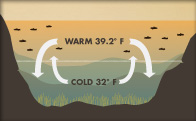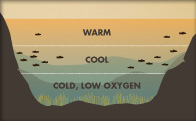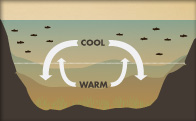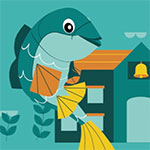Best Time to Freshwater Fish
Learn the best fishing times in freshwaters, what seasonal lake turnover is and how it affects the best time to go freshwater fishing, how water temperature affects freshwater fishing times and more.
Best Freshwater Fishing Times
These are some of the best fishing times to go freshwater fishing. Learning when is the best time will increase your catch rate in the day.
Seasonal Lake Turnover
Turnover refers to the exchange of surface and bottom water in a lake or pond. This annual recycling program happens twice a year, changing the freshwater fishing environment of the lake or pond, which in turn affects the best time to go freshwater fishing. There's spring turnover and fall turnover with summer stagnation in between. During spring turnover, water at the top warms while the bottom stays cool; during fall turnover, warmer water stays insulated at the bottom by the colder water at the top.
An understanding of turnover, combined with knowledge of what kind of water specific fish species like, can give you great insight on knowing when to freshwater fish by choosing the best freshwater fishing times throughout the seasons. As always, good luck.
Spring Turnover
 Once the ice is out, the water on the surface of a lake starts to warm. When it reaches 39 degrees it begins to sink and is replaced by cooler water from below. This exchange continues until the water temperature is constant in the entire lake. Early in this process, fish will stay in the shallow areas of the lake where the water warms up faster, and where the first plant growth of the spring occurs.
Once the ice is out, the water on the surface of a lake starts to warm. When it reaches 39 degrees it begins to sink and is replaced by cooler water from below. This exchange continues until the water temperature is constant in the entire lake. Early in this process, fish will stay in the shallow areas of the lake where the water warms up faster, and where the first plant growth of the spring occurs.
Summer Stagnation
 During the summer, the sun heats water near the surface of lakes, but it doesn't sink. Eventually a condition known as "stratification" develops, putting a well-defined warm layer of water over a cool one. This is probably the easiest season for picking the best time to go freshwater fishing as the temperatures of different layers of water stayed somewhat constant during this stagnation.
During the summer, the sun heats water near the surface of lakes, but it doesn't sink. Eventually a condition known as "stratification" develops, putting a well-defined warm layer of water over a cool one. This is probably the easiest season for picking the best time to go freshwater fishing as the temperatures of different layers of water stayed somewhat constant during this stagnation.
Fish like the cooler water, but they also need the higher oxygen levels found in warmer water. So they'll migrate to an area right between the two levels of water called the thermo cline. The thermo cline can occur between 2 and 10 feet in depth, depending on the size of the lake.
It's best to find a point or some other form of structure that extends out from the shoreline and slopes gradually down into the thermo cline. This should be a good place to fish because the fish often school in this zone because they can find warmer water, but have quick access to deeper, cooler and safer water.
Fall Turnover
 With the arrival of fall and cooler air temperatures, water at the surface of lakes cools, becoming almost as heavy as the cooler bottom water. Strong autumn winds move surface water around, which promotes mixing with deeper water. This is fall turnover.
With the arrival of fall and cooler air temperatures, water at the surface of lakes cools, becoming almost as heavy as the cooler bottom water. Strong autumn winds move surface water around, which promotes mixing with deeper water. This is fall turnover.
As mixing continues, lake water becomes more uniform in temperature and oxygen level, allowing fish to move around freely. Fish can be difficult to find as long as these conditions prevail, usually continues until the weather turns cold, chilling the lake's surface.
Water Temperature And Turnover
Each fish has a different range of water temperature in which it can survive. Although fish cannot always find the exact temperature they prefer, they are usually found in water close to that temperature. By combining a knowledge of preferred water temperature and lake turnover, you can roughly predict when to fish for certain fish at different times of the year.
As a rule, fish that like warmer water will be surface feeders in the summer and bottom feeders in the fall. And fish that like cooler water will feed deep in the spring and on the surface in the fall. For best results, check your local lake forecast for the most up to date information about the best freshwater fishing times in your local area.
Learn the best times to catch trout. Follow these guidelines on our next page to maximize your fishing endeavors.
KEEP LEARNING

First Catch Center Trailer Gallery
FCC Trailer Photo Gallery
LEARN MORE

How to Tie a Duncan Knot
Learn to tie a Duncan knot by following these five simple steps. Watch our new video.
LEARN MORE

Welcome to Angler Academy!
No one said you can’t bring fishing inside! There’s lots of fun activities we can do right from home
LEARN MORE


.png?lang=en-US&ext=.png)